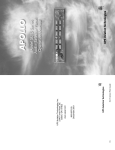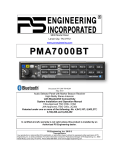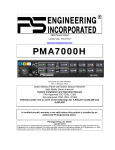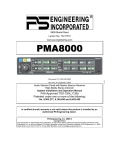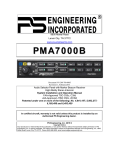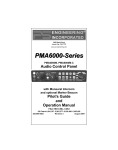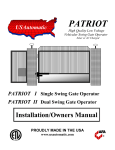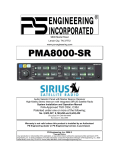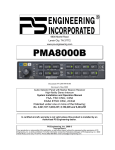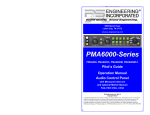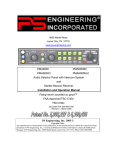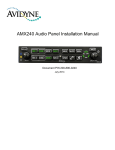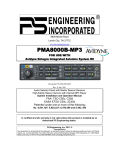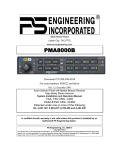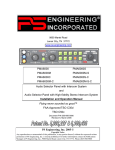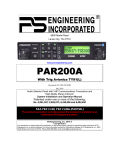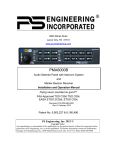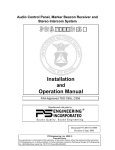Download PMA 7000M Installation Manual
Transcript
9800 Martel Road Lenoir City, TN 37772 www.ps-engineering.com P M A 7 0 00 M Document P/N 200-780-0604 January 2015 Audio Selector Panel with Marker Beacon Receiver/Intercom Replacement for PMA600-Series Audio Panels (mono) System Installation and Operation Manual FAA-Approved TSO C50c, C35d JAA-Approved JTSO C50c, 2C35d Patented under one or more of the following; No. 4,941,187; 5,903,277; 6,160,496 and 6,493,450 In certified aircraft, warranty is not valid unless this product is installed by an Authorized PS Engineering dealer. PS Engineering, Inc. 2015 © Copyright Notice Any reproduction or retransmittal of this publication, or any portion thereof, without the expressed written permission of PS Engineering, Inc. is strictly prohibited. For further information contact the Publications Manager at PS Engineering, Inc., 9800 Martel Road, Lenoir City, TN 37772. Phone (865) 988-9800, email [email protected]. Table of Contents SECTION I GENERAL INFORMATION................................................................................................................................. 1-1 1.1 INTRODUCTION................................................................................................................................................................... 1-1 1.2 SCOPE..................................................................................................................................................................................... 1-1 1.4 PMA6000-SERIES REPLACEMENT ........................................................................................................................................... 1-2 1.5 APPROVAL BASIS -.............................................................................................................................................................. 1-2 1.5 SPECIFICATIONS................................................................................................................................................................. 1-3 1.6 EQUIPMENT SUPPLIED...................................................................................................................................................... 1-4 1.7 EQUIPMENT REQUIRED BUT NOT SUPPLIED ............................................................................................................. 1-4 1.8 LICENSE REQUIREMENTS................................................................................................................................................ 1-4 SECTION II - INSTALLATION ................................................................................................................................................ 2-1 2.1 GENERAL INFORMATION ................................................................................................................................................ 2-1 2.1.1 2.1.2 2.2 2.3 2.3.1 2.3.2 2.3.3 2.3.4 2.3.5 2.3.6 2.3.7 2.4 2.4.1 2.5 2.6 2.7 2.7.1 2.7.2 2.7.3 SCOPE ............................................................................................................................................................ 2-1 CERTIFICATION REQUIREMENTS ........................................................................................................................ 2-1 UNPACKING AND PRELIMINARY INSPECTION ......................................................................................................................... 2-1 EQUIPMENT INSTALLATION PROCEDURES ............................................................................................................................. 2-1 PMA7000M COMPATIBILITY ........................................................................................................................... 2-1 EXISTING PMA6000 REMOVAL ......................................................................................................................... 2-2 NOISE ............................................................................................................................................................... 2-2 EXISTING PMA6000 INSTALLATIONS WITH DROPPING RESISTOR........................................................................ 2-2 POWER ............................................................................................................................................................. 2-2 UNSWITCHED INPUTS ........................................................................................................................................ 2-3 ENTERTAINMENT INPUT .................................................................................................................................... 2-3 MARKER BEACON INSTALLATION .......................................................................................................................................... 2-3 MARKER ANTENNA INSTALLATION ................................................................................................................... 2-4 ADJUSTMENTS .......................................................................................................................................................................... 2-4 COMMUNICATIONS ANTENNA INSTALLATION NOTES ........................................................................................................... 2-4 UNIT INSTALLATION ................................................................................................................................................................ 2-4 REQUIRED TEST EQUIPMENT ............................................................................................................................. 2-5 OPERATIONAL CHECKOUT ................................................................................................................................ 2-5 RECEIVER SENSITIVITY ..................................................................................................................................... 2-6 2.8 FINAL INSPECTION ................................................................................................................................................................... 2-6 SECTION III OPERATION........................................................................................................................................................ 3-1 3.1 SCOPE..................................................................................................................................................................................... 3-1 3.2 POWER SWITCH (EMG-FAIL SAFE OPERATION) ................................................................................................................... 3-1 3.3 MICROPHONE (XMT) SELECTION (ALL MODELS) ................................................................................................................. 3-1 3.3.1 3.4 3.4.1 3.5 3.5.1 3.6 3.6.1 3.6.2 3.6.3 3.6.4 3.7 3.7.1 3.7.2 SWAP MODE (SWITCH FROM COM 1 TO COM 2 REMOTELY) ............................................................................... 3-2 AUDIO SELECTOR .................................................................................................................................................................... 3-2 SPEAKER AMPLIFIER ......................................................................................................................................... 3-2 SPLIT MODE ............................................................................................................................................................................. 3-2 SPLIT MODE INTERCOM .................................................................................................................................... 3-2 INTERCOM OPERATION ........................................................................................................................................................... 3-2 INTELLIVOX® VOX-SQUELCH .......................................................................................................................... 3-2 INTERCOM VOLUME CONTROL .......................................................................................................................... 3-3 INTERCOM MODES ............................................................................................................................................ 3-3 ENTERTAINMENT INPUT .................................................................................................................................... 3-4 BLUETOOTH® INTERFACE....................................................................................................................................................... 3-5 PAIRING AND UNPAIRING BLUETOOTH DEVICES ................................................................................................. 3-5 BLUETOOTH TELEPHONE MODE ........................................................................................................................ 3-5 3.8 MARKER BEACON OPERATION (IF EQUIPPED) ....................................................................................................................... 3-6 SECTION IV- WARRANTY AND SERVICE........................................................................................................................... 4-1 4.1 WARRANTY .............................................................................................................................................................................. 4-1 4.2 FACTORY SERVICE .................................................................................................................................................................. 4-1 APPENDIX A – BOTTOM CONNECTOR INTERCONNECT (FOR REFERENCE ONLY) ............................................... A APPENDIX B TOP CONNECTOR INTERCONNECT (FOR REFERENCE ONLY).............................................................B APPENDIX C- INSTRUCTIONS FOR CONTINUING AIRWORTHINESS .......................................................................... C 7.1 INSTRUCTIONS FOR FAA FORM 337, AUDIO PANELS............................................................................................................... C 7.2 INSTRUCTIONS FOR CONTINUING AIRWORTHINESS, AUDIO SYSTEM ..................................................................................... C APPENDIX D RTCA DO160C (EUROCAE ED-14) ENVIRONMENTAL QUALIFICATION FORM ...................................... D Revision History Rev New By Date Change January 2015 Release of Monaural Version PS Engineering PMA7000M Series Audio Selector Panel and Intercom System Installation and Operator’s Manual Section I GENERAL INFORMATION 1.1 INTRODUCTION The PMA7000M is intended as a replacement for the PS Engineering PMA6000-serial (including UPSAT Apollo SL-10-series), many of which are reaching the end of their useful life due to replacement parts obsolescence and maintenance costs. The PMA7000M offers additional features, such as Bluetooth® connectivity and automatic IntelliVox intercom squelch. Using proprietary IntelliVox® design, this unit eliminates the requirements for intercom squelch adjustments. The unit is designed for outstanding ergonomics and visually defined mode annunciation and selection. Before installing and/or using this product, please read this manual completely. This will ensure that you will take full advantage of all the advanced features in the PMA7000M. 1.2 SCOPE This manual provides detailed installation and operation instructions for the PS Engineering PMA7000Mseries of Audio Selector Panel/Intercom Systems. This includes the following units: Model PMA7000M 1.3 Description Audio Selector Panel with Marker Beacon and Bluetooth Connectivity Part Number 050-781-0604 EQUIPMENT DESCRIPTION The PMA7000M-series is a state of the art audio isolation amplifier and audio selector that contains an automatic voice activated (VOX) intercom system. It can switch up to three transceivers (Com 1, Com 2 and Com 3) and six receivers (Nav 1, Nav 2, ADF, DME, MKR and AUX). There are two unswitched inputs, available for traffic or EGPWS, autopilot disconnect, and/or radar altimeter warning. Unswitched input #1 is also connected to the pilot headset in Fail-safe mode. Push buttons select the receiver audio source provided to the headphones. A SPR button allows the user to listen to the receiver(s) selected on the cabin speaker. Except for the unswitched inputs, all speaker audio is muted during transmit. Push buttons select one of the communication transceivers for the pilot and copilot position, and allows radio transmission. In "Split Mode" the PMA7000M has the ability to allow the pilot and copilot to operate different transceivers independently. A Bluetooth® module is included that adds music (as Music 1) connectivity as well as telephone interface with Bluetooth-enabled smart phones. A fail-safe mode connects the pilot headphone and microphone to COM 1 if power is removed for any reason, or if the power switch is placed in the Off (Fail-safe) position. Unswitched input #1 is also connected to the pilot headset in Fail-safe mode. A six-station voice activated (VOX) intercom is included in the PMA7000M. This system has PS Engineering’s exclusive IntelliVox® circuitry that eliminates manual adjustments. The system contains six separate VOX mic circuits, and only opens the microphone channel in use. The intercom system incorporates pilot isolate and crew modes, two independent music inputs with "Soft Mute," and flashing LED indicators for transmit indications. Intercom control is through two front panelmounted volume knobs and 3-position mode switch. The concentric volume controls the intercom level for the pilot and copilot, while the outer knob controls the passenger intercom volume. Intercom squelch is automatic. 200-780-0604 Page 1-1 January 2015 PS Engineering PMA7000M Series Audio Selector Panel and Intercom System Installation and Operator’s Manual An “Alternate Intercom Mode” is incorporated in PMA7000M (requires extra wiring in a PMA6000 installation). This allows the passengers and crew to converse, but removes radio traffic from the passengers’ headphones, and blocks passenger mics from the crew during radio receptions. A 3-light Marker Beacon receiver is integrated in the PMA7000M. This provides the necessary Marker Beacon lights and audio indications necessary for an Instrument Landing System (ILS) approach. 1.4 PMA6000-series replacement The PMA7000M is backward compatible with the following units: PMA6000 Audio Panel, NO Marker PMA6000M Audio Panel, with Marker PMA6000C Audio Panel, NO Marker, 3-COM capability PMA6000M-C Audio Panel, with Marker, 3-COM capability Apollo SL-10 Audio Panel, NO Marker Apollo SL-10M Audio Panel, with Marker No wiring changes are needed, except in cases where additional capabilities are desired. 1.5 APPROVAL BASIS - FAA-TSO and EASA JTSO Approval. The PMA7000M-series Audio Selector Panels are FAA approved under TSO C50c (Audio Amplifiers) and TSO C35d (Marker Beacon Receivers). In addition, they are approved by the European Aviation Safety Agency under JTSO C50C and JAR-TSO 2C35d (EASA.IM.210.10028565). All systems comply with relevant portions of EUROCAE RTCA MPS WG No. 7/70, DO-143 and (Marker Beacon Receivers), ED-14C/DO-160C (Environmental Conditions and Test Procedures for Airborne Equipment), ED12B/DO-178B (Software Considerations for Airborne Equipment) and ED- 18/DO-214 (Audio Systems Characteristics and Minimum Operational Performance Standards for Aircraft Audio Systems). Operation is subject to the following conditions: This device may not cause harmful interference. This device must accept any interference received, including interference that may cause undesired operation. 200-780-0604 Page 1-2 January 2015 PS Engineering PMA7000M Series Audio Selector Panel and Intercom System Installation and Operator’s Manual 1.5 SPECIFICATIONS TSO COMPLIANCE C35d, Class A C50c, Class A RTCA/DO-214 RTCA/DO-143 RTCA/DO-160C RTCA/DO-178B ENVIRONMENTAL Qualifications: A1D1/CA(MN)XXXXXXBBBBTBKXX Operating Temperature Range: -15º C to 55ºC Altitude: Up to 50,000 feet in an non-pressurized area DIMENSIONS: Height: 1.3 in. (3.3 cm) Width: 6.25 in. (16.9 cm) Depth: 6.8 in. (17.3 cm) WEIGHT (With Rack & Connectors): 1.5 lb. (0.54 kg) POWER REQUIREMENTS (Including Internal Lighting): Voltage: 11 to 33 VDC Maximum Current: 2.5 Amp (Externally protected by a 3A pull-type breaker) Audio Selector Specifications Audio selector panel input impedance: 510 Input Isolation: -60 dB (min.) Speaker Muting: -60 dB (min.) Speaker Output (into 4 ) with no clipping 3 Watts (min.) 14 VDC: 10 Watts (min.) 28 VDC: Receiver Inputs: 9 (Com 1, Com 2, Com 3, Nav 1, Nav 2, ADF, DME, MKR, AUX) Unswitched Inputs: 4 Transmitter Selections: 5 (Com 1, Com 2, Com 3 Com1/2, Com1/3) Speaker Impedance: 4 Headphone Impedance: 150 – 1000 Headphone Output: 38 mW each headset, no clipping <1% THD Microphone Impedance: 150 - 600 Intercom Specifications Marker Beacon: Audio Selector/Intercom: APPLICABLE DOCUMENTS: Intercom Positions: Music Inputs: Music Muting: Distortion: Mic Freq. Response, 3 dB: Music Freq. Response, 3 dB: Frequency: Sensitivity: Low: High: Selectivity: External Lamp Output: MM Sense: 200-780-0604 6 places (with individual IntelliVox® circuits) 2, (Independent, Stereo) >-30 dB "Soft Mute" when Com or intercom active. <1% THD @ 38 mW into 150 300 Hz - 6000 Hz 20 Hz - 18kHz MARKER BEACON RECEIVER: (if equipped) 75 MHz Crystal Controlled Capable of: (preset at factory for field application) 1000 Volts (Hard) (360 to 570 V soft) 200 Volts (Hard) (130 to 200 V soft) -6 dB at ±10 kHz -40 dB at ±120 kHz 7.5 (±4 VDC unloaded, at maximum brightness) VDC positive when active, max. current 125 mA Active high (4.5 ± 1.0VDC) Page 1-3 January 2015 PS Engineering PMA7000M Series Audio Selector Panel and Intercom System Installation and Operator’s Manual 1.6 EQUIPMENT SUPPLIED 1 ea. of the following units: Model PMA7000M 1.7 Description PMA7000M Audio Panel with Marker Beacon and Stereo intercom. Part Number 050-780-0604 EQUIPMENT REQUIRED BUT NOT SUPPLIED a) b) c) d) Installation kit and tray (uses exiting PMA6000M-series installation) Headphones, 150 (Monaural), up to 6 as required Microphones, up to 6 as required Marker Antenna (75 MHz, VSWR <1:1.5, and appropriate for the airspeed) 1.8 LICENSE REQUIREMENTS None Bluetooth™ Radio approval: FCC ID: QOQWT32AE Industry Canada ID: 5123A-BGTWT32AE CE EMC Directive 89/36/EEC as amended by Directives 92/31/EEC and 93/68/EEC 200-780-0604 Page 1-4 January 2015 PS Engineering PMA7000M Series Audio Selector Panel and Intercom System Installation and Operator’s Manual Section II - Installation 2.1 GENERAL INFORMATION 2.1.1 SCOPE This section provides detailed installation and interconnection instructions for the PS Engineering PMA7000M-Series Audio Selector Panel/Intercom/ with internal Marker Beacon. Please read this manual carefully before beginning any installation to prevent damage and post-installation problems. Installation of this equipment requires special tools and knowledge. 2.1.2 Certification Requirements The PMA7000M has an identical certification to the PMA6000-series it replaces. Refer to FAA Advisory Circular AC 20-41A, Substitute Technical Standard Order (TSO) Aircraft Equipment, April 5, 1977 for guidance in complying with equipment installation. NOTE Failure to follow any of the installation instructions, or installation by a non-certified individual or agency will void the warranty, and may result in an unairworthy installation. Installing an audio panel with a Marker Beacon receiver will require aircraft testing. See §2.10. 2.2 Unpacking and Preliminary Inspection Use care when unpacking the equipment. Inspect the units and parts supplied for visible signs of shipping damage. Examine the unit for loose or broken buttons, bent knobs, etc. Verify the correct quantity of components supplied with the list in Section 1.6 (B). If any claim is to be made, save the shipping material and contact the freight carrier. Do NOT return units damaged in shipping to PS Engineering. If the unit or accessories show any sign of external shipping damage, contact PS Engineering to arrange for a replacement. Do Not attempt to install a damaged unit in an aircraft under any circumstances. Equipment returned to PS Engineering for any other reason should be shipped in the original PS Engineering packaging, or other UPS approved packaging. 2.3 Equipment Installation Procedures 2.3.1 PMA7000M Compatibility The PMA7000M is backward compatible with the following units: PMA6000 Audio Panel, NO Marker PMA6000M Audio Panel, with Marker PMA6000C Audio Panel, NO Marker, 3-COM capability PMA6000M-C Audio Panel, with Marker, 3-COM capability Apollo SL-10 Audio Panel, NO Marker Apollo SL-10M Audio Panel, with Marker All PMA7000M units have internal marker beacon receiver/indicator. It is the installer’s responsibility to determine installation compatibility. 200-780-0604 Page 2-1 January 2015 PS Engineering PMA7000M Series Audio Selector Panel and Intercom System Installation and Operator’s Manual 2.3.2 Existing PMA6000 removal A 3/32” Allen hex wrench is required. To remove the exiting PMA6000 audio panel; locate the 3/32” hexhead screw in the center of the bezel faceplate. It may be necessary to remove the copilot knobs by pulling each one straight toward the front Turn the hex wrench counterclockwise to release the screw. As the screw is backed out, gently pull the edges of the bezel to “help” the unit out of the tray, and prevent the hold-down crew from becoming dislodged. NOTE: The PMA7000M is intended to replace existing PMA6000 units, and installation material is not provided. PS Engineering can supply material, and make a custom wiring harness for the unit. Call 1-800ICS-AERO or see www.ps-engineering.com for details. 2.3.3 Noise Due to the variety and the high power of radio equipment often found in today's general aviation aircraft, there is a potential for both radiated and conducted noise interference. The PMA7000M power supply is specifically designed to reduce conducted electrical noise on the aircraft power bus by at least 50dB. Although this is a large amount of attenuation, it may not eliminate all noise, particularly if the amplitude of noise is very high. There must be at least 13.8 VDC present at the bottom connector, pin 20, of the PMA7000M for the power supply to work in its designed regulation. Otherwise, it cannot adequately attenuate power line noise. Shielding can reduce or prevent radiated noise (i.e., beacon, electric gyros, switching power supplies, etc.) However, installation combinations can occur where interference is possible. The PMA7000M was designed in a RFI hardened chassis and has internal Electromagnetic Interference (EMI) filters on all inputs and outputs. Ground loop noise occurs when there are two or more ground paths for the same signal (i.e., airframe and ground return wire). Large cyclic loads such as strobes, inverters, etc., can inject noise signals onto the airframe that are detected by the audio system. Follow the wiring diagram very carefully to help ensure a minimum of ground loop potential. Use only Mil Spec shielded wires (MIL-C-275000, or better).Under no circumstances combine a microphone and headphone wiring into the same shielded bundle. Always use a 2- or 3-conductor, shield wire as shown on the installation wiring diagram. Radiated signals can be a factor when low level microphone signals are "bundled" with current carrying power wires. Keep these cables physically separated. It is very important that you use insulated washers to isolate the ground return path from the airframe to all headphone and microphone jacks. Adding a high-performance audio control system, particularly in conjunction with high-performance active noise canceling headsets, cannot improve on older avionics that were designed for cabin-speaker use. PS Engineering makes no claim that the audio panel will provide a noise-free audio quality under all installation conditions, particularly with older avionics. 2.3.4 Existing PMA6000 installations with dropping resistor. In 28-Volt aircraft, the dropping resistor may be removed, but removal is not required. 2.3.5 Power The PMA7000M-Series are compatible with both 14 and 28 Volt DC systems. A two (2) Amp circuit breaker is required. Power and ground wires must be a twisted #18 AWG pair. Connect airframe power ground to J1 (bottom connector) Pin Z only. No dropping resistors are required for 28V installation. 200-780-0604 Page 2-2 January 2015 PS Engineering PMA7000M Series Audio Selector Panel and Intercom System Installation and Operator’s Manual 2.3.5.1 Fail Safe Connection The PMA7000M connects the pilot microphone and headphone directly to COM 1 input when power is removed. The headphone failsafe is the TIP of the headphone jack, to be compatible with monaural headphones. Unswitched input #1 (Bottom Connector pin T) is also provided to the pilot headset in fail-safe. NOTE: The pilot headphone MUST be wired in accordance with Appendix C, Bottom connector Pin 3 to Pilot headphone tip to ensure proper failsafe operation. Verify failsafe operation in accordance with systems checkout procedures. 2.3.6 Unswitched inputs J1, pins T & 17 are unswitched, unmuted inputs. These inputs are presented to the pilot and copilot regardless of the audio configuration, and will always mute the music inputs. These 510 Ω inputs can be used for altimeter DH audio, GPS waypoint audio, autopilot disconnect tones, or any other critical audio signal. J1Pin T is provided to the pilot’s headset even when the unit is off, or in fail-safe mode. 2.3.6.1 Alternate Intercom Mode (Bottom connector Pin 14) If an external switch is installed between pin 14 of the bottom connector and ground, the PMA7000M can be placed into “Alternate Intercom Mode.” In this mode, when the ICS is in “ALL” mode, the passengers will not hear aircraft radio. In addition, the passengers’ microphones are not heard by the crew when the radios are active. 2.3.7 Entertainment Input The PMA7000M has two INDEPENDENT music inputs. Entertainment input number 1 is J2 pin 4, WRT pin D, and is provided to the pilot and copilot. Entertainment number 2 is provided to the passengers at all times and pilot & copilot will never hear music number 2. NO T E: Us e t h e lo w le ve l o utp u t o f a n y ad d i tio n al e n ter ta i n me nt d e vi ce to co n ne ct to th e a ud io p a n el. Ma x i m u m s i g nal le v el i s 2 V A C p -p . DO N O T u se a s p ea ker - le ve l o ut p ut, t hi s wi ll ca u se i nt er na l d a ma g e i n t h e a u d io p a ne l. 2.3.7.1 Bluetooth® entertainment The PMA7000M incorporates Bluetooth music. This is presented to the pilot and copilot on the Music 1 input. In addition, the Bluetooth music can be distributed to both the crew and passengers if desired. Hold the ICS button for more than one second to distribute the Bluetooth music to all headsets. Hardwired music number 1 is not distributed to all headsets in this mode, only Bluetooth music. 2.3.7.2 Entertainment muting The PMA7000M-system incorporates a "Soft Mute" system. This will mute the music devices during ICS or radio conversation. Any signal appearing in the unswitched audio inputs will always mute the music sources, even though the passengers may not hear the audio tone itself. Caution: Local oscillators and internal signals from entertainment equipment can cause undesired interference with other aircraft systems. Before takeoff, operate the entertainment devices to determine if there is any adverse effect within the aircraft systems. If any unusual operation is noted in flight, immediately switch off the entertainment devices. All additional entertainment devices must be switched off for both takeoff and landing. 2.4 Marker Beacon Installation A marker beacon receiver and indicator are included in the PMA7000M. 200-780-0604 Page 2-3 January 2015 PS Engineering PMA7000M Series Audio Selector Panel and Intercom System Installation and Operator’s Manual 2.4.1 Marker Antenna Installation A marker beacon antenna, appropriate to the type and speed of the aircraft, is required (not included). Refer to aircraft and antenna manufacturer's installation instructions, as well as AC43.13-2A (or later revision), Chapter 3, for information on proper antenna installation techniques. The marker beacon antenna must be mounted on the bottom of the aircraft. 2.5 Adjustments The PMA7000M is factory adjusted to accommodate the typical requirements for most aircraft configurations. There are four adjustments however, that will allow the installer to tailor the specific functions. The unit will have to be removed from the tray to make these adjustments. Speaker Volume Marker GainHI Marker Volume Marker Gain LO Figure 2-1- PMA7000M Adjustments 2.6 Communications Antenna Installation Notes For best results while in Split Mode, it is recommended that the one VHF communications antenna is located on top of the aircraft while the other communications antenna is installed on the bottom. Any antenna relocation must be accomplished in accordance with AC 43.13-2A, aircraft manufacturers’ recommendations and FAA-approved technical data. Warning: It is probable that radio interference will occur in the split mode when the frequencies of the two aircraft radios are adjacent, and/or the antennas are physically close together. PS Engineering makes no expressed or implied warranties regarding the suitability of the PMA7000M in Split Mode. 2.7 Unit Installation To install the PMA7000M, gently slide the unit into the mounting rack until the hold-down screw is engaged. While applying gentle pressure to the face of the unit, tighten the 3/32" hex-head in the center of the unit until it is secure. DO NOT OVER TIGHTEN. 200-780-0604 Page 2-4 January 2015 PS Engineering PMA7000M Series Audio Selector Panel and Intercom System Installation and Operator’s Manual Wa r ni ng : Do no t o ver - t ig h te n t he lo c k d o wn scr e w wh i le i n s ta ll i n g t h e u ni t i n tr a y. Internal damage will result. 2.7.1 Required Test Equipment In order to return an aircraft to service after installation of the PMA7000M, the installer must have access to a Marker Beacon signal generator: a. IFR NAV401L, NAV402AP, IFR4000 b. TIC T-30D, T-36C Equivalent test equipment is acceptable as long as the testing requirements can be met. 2.7.2 Operational Checkout NOTE: The IntelliVox® is designed for ambient noise levels of 80 dB or above. Therefore some clipping may occur in a quiet cabin, such as without the engine running, in a hangar. This is normal. 1. 2. 3. 4. 5. 6. 7. 8. 9. 10. 11. 12. 13. 14. 15. 16. Apply power to the aircraft and avionics. Plug headsets into the pilot, copilot, and occupied passenger positions. Verify fail-safe operation by receiving and transmitting on com 1 from the pilot position, with the audio panel power off. Switch on the unit by pressing the volume (VOL) knob. Check intercom operation. Push the Com 1 Xmt select button (lower row). Verify that both of the Com 1 buttons light. Verify that transmit Com 1 button LED (Light Emitting Diode) is not blinking. If the LED is blinking, stop testing and troubleshoot the microphone PTT installation. Verify proper transmit and receive operation from the copilot position, noting that the copilot PTT switch allows proper transmission on the selected transceiver. Verify that the Com 1 Xmt button blinks when transmitting. Verify that pushing the COM 2 button causes the button to illuminate, and the Com 2 receiver to be heard. Verify operation on Com 2 from the pilot position. Repeat for Com 2 for copilot and check Com 3 for both pilot & copilot, (if installed). Press and hold the Com 1 Xmt button. While holding the Com 1 Xmt button, press the Com 2 Xmt button at the same time. This places the unit in “Split Mode;” Verify that the pilot can transmit and receive on Com 1, while the copilot transmits and receives on Com 2. Verify proper operation of all receiver sources by selecting them using the appropriate button. The button illuminates to show which source is in use. Push the SPR button. Verify that all selected audio is heard in the cockpit speaker. Verify that the audio mutes in the speaker when the mic is keyed. Verify that the appropriate LED (Com 1 or Com 2 transmit) blinks when either push to talk (PTT) is keyed. Verify proper Intercom system operation in the ALL, ISO and CREW modes (see Table 3-1). Verify that the audio selector panel system does not adversely affect any other aircraft system by systematically switching the unit on and off, while monitoring the other avionics and electrical equipment on the aircraft. 2.7.2.1 Marker Checkout 1. Connect a ramp generator at the antenna end of the marker coax. With the unit under test in HI sensitivity, verify that a 160 V, modulated 95% with 1300 Hz, signal will illuminate the amber (M) marker light, and that marker audio is present in the headphones when the Marker Audio (M) push-button has been depressed. Select SPR for speaker to verify marker audio availability on the cabin speaker. Verify that the white (I) and blue (O) lights will illuminate within 3dB of the amber lamp, with 3000 HZ and 400 Hz applied, respectively. 200-780-0604 Page 2-5 January 2015 PS Engineering PMA7000M Series Audio Selector Panel and Intercom System Installation and Operator’s Manual 2. 3. Repeat with the unit in LOW sensitivity, with 430 Volts applied. Connect the marker antenna and verify proper operation. 2.7.3 Receiver Sensitivity Although the receiver meets FAA TSO-C35d sensitivity specifications, the sensitivity has been adjusted to meet real world requirements (150V and 430V, soft). This will usually eliminate the need for the avionics shop to reduce the sensitivity in the field so as to prevent early detection of the marker beacons. If your particular installation requires more or less sensitivity, see adjustment section 2.6, and figure 2-1. 2.8 Final Inspection Verify that the wiring is bundled away from all controls and no part of the installation interferes with aircraft control operation. Move all controls through their full range while examining the installation to see that no mechanical interference exists. Verify that the cables are secured to the aircraft structure in accordance with good practices, with adequate strain relief. Ensure that there are no kinks or sharp bends in the cables and coaxial cables. Verify that the cables are not exposed to any sharp edges or rough surfaces, and that all contact points are protected from abrasion. Complete logbook entry, or any other documentation as necessary. Return completed warranty registration application to PS Engineering, or register online at www.psengineering.com/support.shtml . 200-780-0604 Page 2-6 January 2015 PS Engineering PMA7000M Audio Selector Panel and Intercom System Installation and Operator’s Manual Section III OPERATION GENERAL INFORMATION 3.1 SCOPE This section provides detailed operating instructions for the PS Engineering PMA7000M, Audio Selector Panel/Intercom Systems. Please read it carefully before using the equipment so that you can take full advantage of its capabilities. This section is divided into four sections covering the basic operating areas of the PMA7000M systems. They are Audio Selector, Transceiver Selection, Intercom, and Marker Beacon Receiver (Marker version only). RECEIVE AUDIO SELECTORS MARKER INDICATOR LAMPS MARKER MODE IINTERCOM MODE TRANSMIT SELECTORS CREW ICS VOLUME (INNER) PASS ICS VOLUME (OUTER) CREW ICS ♫ MUTE CONTROL SPEAKER CONTROL Figure 3-1 PMA7000M controls 3.2 Power Switch (EMG-Fail Safe Operation) Unit power is turned on and off by pushing the volume knob. In the OFF or "EMG" position, the pilot is connected directly to Com 1. This allows communication capability regardless of unit condition. Any time power is removed or turned OFF, the audio selector will be placed in the fail-safe mode. The power switch also controls the audio selector panel functions, intercom and marker beacon receiver. 3.3 Microphone (XMT) Selection (All models) There are six pushbuttons associated with the communications transceivers. The lower buttons control which transceiver is selected for transmit. The PMA7000M gives priority to the pilot’s PTT. If the copilot it transmitting, and the pilot presses his PTT, the pilot’s microphone will be heard over the selected com transmitter. The PMA7000M has an automatic selector mode. Audio from the selected transceiver is automatically heard in the headsets and speaker (if selected). You can check this function by switching from COM 1 to COM 2 and watch the selected audio light on the selector change from COM 1 to COM 2. This ensures the pilot will always hear the audio from the transceiver he is transmitting on. When switching from COM 1 to COM 2, while COM 2 audio had been selected, Com 1 audio will continue to be heard. This eliminates the pilot having to switch Com 1 audio back on, if desired. When switching from COM 1 to COM 2 while Com 2 has NOT been selected, Com 1 audio will be switched off. In essence, switching the mic selector will not effect the selection of Com receiver audio. 200-780-0604 Page 3-1 January 2015 PS Engineering PMA7000M Audio Selector Panel and Intercom System Installation and Operator’s Manual 3.3.1 Swap Mode (Switch from Com 1 to Com 2 remotely) With a yoke mounted, momentary switch, the pilot can change from the current Com transceiver to the other by depressing this switch. To cancel "Swap Mode," the pilot may either press the yoke mounted switch again, or select a different Com with the XMT buttons. . 3.4 Audio Selector Receiver audio is selected through seven momentary, push-button, backlit switches. You will always hear the audio from the transceiver that is selected for transmit. The users can identify which receivers are selected by noting which of the green switch LEDs are illuminated. Pushbuttons labeled Nav 1, Nav 2, MKR (Marker), ADF, DME, AUX (auxiliary), and SPR (Speaker) are momentary switches. When one of the buttons is pressed, the source becomes active, and the LED illuminates. Press the switch again and it turns off and removes that receiver from the selected audio. 3.4.1 Speaker Amplifier The "SPR" in the push-button section stands for speaker. This switch will place all selected audio on the cockpit speaker when this switch is selected. NOTE: Except for the unswitched audio, the speaker amplifier is not active in the "Split Mode." Unswitched audio, (autopilot disconnect, altimeter warning, etc.) will come through the speaker regardless of the speaker button position. 3.5 Split Mode The split mode can be activated at any time by pressing the desired combination of XMT buttons. For instance, to activate a Com 1/Com 2 split, press and hold the Com 1 button, and then press the Com 2 button while holding the Com 1 button. This places the pilot on Com 1 and the Copilot on Com 2. Split mode for Com 3 is possible with pilot on Com 1, copilot on Com 2 or 3. Pilot on Com 2 or Com 3 and Copilot on Com 1 is not possible. Note: Due to the nature of VHF communications signals, and the size constraints in general aviation aircraft, it is probable that there will be some bleed-over in the Split mode, particularly on adjacent frequencies. PS Engineering makes no warranty about the suitability of Split Mode in all aircraft conditions. Note: Split Mode does not turn off other (Nav, ADF, etc.) selected audio to pilot. However, the copilot will only hear the selected communications receiver. 3.5.1 Split Mode Intercom In split mode, the pilot and copilot are usually isolated from each other on the intercom, simultaneously using their respective radios. Depressing the ICS button in Split Mode will activate VOX intercom between the pilot and copilot positions. This permits intercommunication when desired between the crew. Pressing the ICS button again disables this crew intercom function. 3.6 Intercom Operation 3.6.1 IntelliVox® VOX-Squelch No adjustment of the IntelliVox® squelch control is necessary. There is no field adjustment. Through three individual signal processors, the ambient noise appearing in all six microphones is constantly being sam- 200-780-0604 Page 3-2 January 2015 PS Engineering PMA7000M Audio Selector Panel and Intercom System Installation and Operator’s Manual pled. Non-voice signals are blocked. When someone speaks, only their microphone circuit opens, placing their voice on the intercom. The system is designed to block continuous tones, therefore people humming or whistling in monotone may be blocked after a few moments. For consistent performance, any headset microphone must be placed within ¼-inch of your lips, preferably against them. (ref: RTCA/DO-214, 1.3.1.1 (a)). It is also a good idea to keep the microphone out of a direct wind path. Moving your head through a vent air stream may cause the IntelliVox® to open momentarily. This is normal. The IntelliVox® is designed to work with normal aircraft cabin noise levels (70 dB and above). It loves airplane noise! Therefore, it may not recognize speech and clip syllables in a quiet cabin, such as in the hangar, or without the engine running. This is normal. For optimum microphone performance, PS Engineering recommends installation of a Microphone Muff Kit from Oregon Aero (1-800-888-6910). This will not only optimize VOX performance, but will improve the overall clarity of all your communications. Table 3-1 Mic Muff ™ Part Numbers Manufacturer Bose David Clark Lightspeed Model Dynamic Electret M87 Dynamic H10-30 H10-20, H10-40 H10-13.4 15K & 20K Peltor 7003 7004 90010 90015 Pilot 11-20 & 11-90 90015 Sennheiser Telex 3.6.2 Mic Muff™ Part Number 90010 90015 90020 90010 90015 90015 90015 90015 Airman 750 AIR3000 90015 90010 Intercom Volume Control The inner volume control knob adjusts the loudness of the intercom for the pilot and copilot. It has no effect on selected radio levels, music input levels or passengers' volume level. The outer volume control knob controls intercom volume or the passengers. It has no effect on radio or music levels. Adjust the radios and intercom volume for a comfortable listening level. Most general aviation headsets today have built-in volume controls; therefore, volume also can be further adjusted at the individual headset. 3.6.3 Intercom Modes The lower switch on the left side is a 3-position mode switch that allows the pilot to tailor the intercom function to best meet the current cockpit situation. The description of the intercom mode function is valid only when the unit is not in the "Split" mode. Then, the pilot and copilot intercom is controlled with the ICS button. ISO: (Up Position): The pilot is isolated from the intercom and is connected only to the aircraft radio system. He will hear the aircraft radio reception (and sidetone during radio transmissions). Copilot will hear passengers’ intercom and Entertainment 1, while passengers will hear copilot intercom and Entertainment 2. Neither will hear aircraft radio receptions or pilot transmissions. 200-780-0604 Page 3-3 January 2015 PS Engineering PMA7000M Audio Selector Panel and Intercom System Installation and Operator’s Manual ALL: (Middle Position): All parties will hear the aircraft radio and intercom. Crew will hear Entertainment 1, passengers will hear Entertainment 2. During any radio or intercom communications, the music volume automatically decreases. The music volume increases gradually back to the original level after communications have been completed. CREW (Down Position): Pilot and copilot are connected on one intercom channel and have exclusive access to the aircraft radios. They may also listen to Entertainment 1. Passengers can continue to communicate with themselves without interrupting the Crew and also may listen to Entertainment 2. Anytime the PMA7000M is in either the COM 1/COM 2, COM 1/COM 3 ("Split Mode"), the pilot and copilot intercom is controlled with the ICS button. The passengers will maintain intercommunications, but never hear aircraft radios. 3.6.3.1 Alternate Intercom Mode (additional wiring required) If an external switch is installed, the PMA7000M can be placed into “Alternate Intercom Mode.” In this mode, the passengers will not hear aircraft radio in the ALL intercom mode. In addition, the passengers’ microphones are not heard by the crew when the radios are active. 3.6.4 Entertainment Input The audio selector panel has provisions for two separate music input devices. Music 1 feeds the pilot and copilot positions. They operate independently in the PMA7000M. The volume control does not affect the music level. While in the ISO (Isolate) mode, the copilot will hear Entertainment 1 while the four passengers will hear Entertainment #2. The pilot will hear music 1, at a muted level. In normal operation, whenever a person speaks, or if the aircraft radio becomes active, the music will automatically mute and then will gradually return to the original listening level when the intercom or radio conversation ceases. When in the ALL mode, pilot and copilot will hear Entertainment 1 input while all passengers will hear the Entertainment 2 source. While in the CREW mode, pilot and copilot will hear music input #1 while the passengers may listen to music input #2. 3.6.4.1 Bluetooth music distribution to all headsets The Bluetooth music source can be distributed to crew and passengers by pressing and holding the ICS button for more than 1 second. 3.6.4.2 Soft Mute and Soft Mute inhibit The Soft Mute feature assures that the aircraft radio transmissions will not be missed due to music playing. When there is radio reception or intercom conversation, the music level is dropped to a low, or background level. When the radio or intercom traffic ceases, the level gradually returns to normal. The front panel ICS switch controls muting of music source #1 (for pilot and copilot). Pushing this button places the ICS in Karaoke (or sing along) mode, which inhibits the soft mute feature. This allows the music to continue uninterrupted by intercom or radio traffic when cockpit workload is appropriate. Pushing the button again will release the mute inhibit function. The passenger music, source #2, can be placed in the Karaoke mode if a remote switch has been installed in the aircraft. Mode Isolate Pilot Hears A/C Radios Pilot Sidetone (during radio transmission) Entertainment 1 is Muted Copilot Hears Copilot and passenger intercom Entertainment #1 Passenger Hears Passenger and Copilot intercom Entertainment #2 Bluetooth® Telephone “Phone Booth” mode Pilot has exclusive use of the telephone. All Pilot Copilot Copilot Pilot Passengers Pilot All have access to phone. 200-780-0604 Page 3-4 Comments This mode allows the pilot to communicate without the others bothered by the conversations. Copilot and passengers can continue to communicate and listen to music This mode allows all on board to hear radio re- January 2015 PS Engineering PMA7000M Audio Selector Panel and Intercom System Installation and Operator’s Manual Crew A/C Radio Passengers Entertainment #1 A/C Radio Passengers Entertainment #1 Copilot A/C Radio Entertainment #2 Pilot Copilot A/C Radio Entertainment #1 Copilot Pilot A/C Radio Entertainment #1 Passengers Entertainment #2 Pilot and copilot have phone access. ception as well as communicate on the intercom. Music and intercom is muted during intercom and radio communications This mode allows the pilot and copilot to concentrate on flying, while the passengers can communicate amongst themselves. Table 3-2 Intercom Modes 3.7 Bluetooth® interface The PMA7000M has a Bluetooth interface. The audio panel is always “discoverable,” so you just need to search for the PMA7000M from your Bluetooth-equipped phone or music source. The default access code is 0000, if needed. Once the PMA7000M has been “paired” with your Bluetooth device, the TEL distribution will act as described in § 3.7.2 Calls are answered or made from the telephone handset. You can disconnect from the handset. The pilot and copilot will have transmit capability on the other selected transceiver Com 1 or 2, simply by using their respective PTT switch. In CREW mode, the pilot and copilot are the only ones that use the telephone. In ISO intercom mode, the pilot position is in the "Phone Booth." Only the pilot will hear the telephone, and only he will be heard. He will also have access to radios and will transmit on that radio using the PTT. All selected audio is provided. In ISOLATE pilot will not have telephone sidetone. In ALL mode, everyone will be on the Bluetooth phone call, “Party Line”. Note: Because the cellphone uses an intercom circuit, all stations on that circuit will lose intercom capability when the cellphone is in use. 3.7.1 Pairing and unpairing Bluetooth devices The PMA7000M can be paired with up to eight individual devices. When that number is exceeded, one device will be automatically un-paired to allow the new device. The device eliminate will be selected at random by the Bluetooth module. Hint, if your old phone is not recognized by the PMA7000M, you may simply need to re-pair. To reset the Bluetooth, Hold Nav 1 and Nav 2 buttons at the same time for more then 3 seconds. 3.7.1.1 Pairing separate music and telephone devices It is possible to use a different music source (iPad, iPod with Bluetooth adapter, Bluetooth enabled laptop, etc) and telephone. However, the music source must be paired first, before the telephone, if the telephone also has music streaming capability. Otherwise, the Smartphone will also take over the music streaming. Note: iPhones will probably take control over other music devices. In Droid you may select music or phone only. With Blackberry, you may have to manually select the PMA7000M as audio source for each call. 3.7.2 Bluetooth Telephone Mode When a Bluetooth-enabled telephone is paired and connected with the PMA7000M, the audio panel will serve as a connection to the aircraft occupants. You can make and answer calls from the telephone handset. In some cases, you will need to select the PMA7000M as your audio source to connect on a call: 200-780-0604 Page 3-5 January 2015 PS Engineering PMA7000M Audio Selector Panel and Intercom System Installation and Operator’s Manual When the handset is active, the audio will be routed to the passengers and crew as follows: In ALL intercom mode, all crew and passengers will be heard on the phone when they speak. All will hear selected audio. COM audio is automatically heard in the headsets. In CREW mode, the pilot and copilot are connected to the telephone. The pilot and copilot will have transmit capability on the other selected transceiver COM 1 or 2, simply by using their respective PTT switch. In ISO intercom mode, when the PMA7000M is in the TEL mode, the pilot position is in the "Phone Booth." Only the pilot will hear the telephone, and only he will be heard. He will also have access to COM 1 or 2, and will transmit on that radio using the PTT. All selected audio is provided. Warning: United States FCC Regulations contained in 47 CFR § 22.925 contain prohibition on airborne operation of cellular telephones. “Cellular telephones installed in or carried aboard airplanes, balloons or any other type of aircraft must not be operated while such aircraft are airborne (not touching the ground). When any aircraft leaves the ground, all cellular telephones on board that aircraft must be turned off.” NOTE Because the cell phone uses an intercom circuit, all stations on that circuit will lose intercom capability when the cell phone is in use. Intercom conversations will still be present if the cell phone provides sidetone, or if the audio panel is modified for telephone sidetone. PS Engineering does not guarantee compatibility with personal cellular telephones. Visit www.ps-engineering.com for a list of phones that have been tested. 3.7.2.1 Cellular telephone sidetone As shipped from PS Engineering, the PMA7000M provides cellular telephone sidetone (the user’s voice fed back to the headset). Some cell phones provide sidetone. In PMA7000M Telephone sidetone can be enabled/disabled by an internal modification. Contact PS Engineering for information. 3.8 Marker Beacon Operation (If equipped) The optional Marker Beacon Receiver uses visual and audio indicators to alert you when the aircraft passes over a 75 MHz transmitter. The Blue lamp, labeled "O," is the Outer Marker lamp and has an associated 400 Hertz 'dash' tone. The lamp and tone will be keyed at a rate of two tones/flashes per second when the aircraft is in the range of the Outer Marker Beacon. The Amber lamp, labeled "M," is the Middle Marker lamp and is coupled with a 1300 Hertz tone. It is keyed alternately with short 'dot' and long 'dash' bursts at 95 combinations per minute. The White lamp, labeled "I," is the Inner marker and has a 3000 Hertz 'dot' tone. The lamp and tone will be keyed at a rate of six times per second. The audio from the Marker Beacon Receiver can be heard by selecting the "MKR" push-button switch. To adjust the volume level, there is a service adjustment located on the top of the unit. A three-position switch is used to set the receiver sensitivity and to test the indicator lamps. Use "HI" sensitivity initially. This allows you to hear the outer marker beacon about a mile out. Then select the “LO” sensitivity to give you a more accurate location of the Outer Marker. The momentary down switch position 200-780-0604 Page 3-6 January 2015 PS Engineering PMA7000M Audio Selector Panel and Intercom System Installation and Operator’s Manual is marker test, labeled "T/M" and illuminates all three lamps simultaneously to assure the lamps (internal and external) are in working order. TST does not activate MM sense output. Pressing the marker mode select down (to “T/M”) will cause the marker audio to mute for that beacon. The next beacon received will re-activate the audio. 200-780-0604 Page 3-7 January 2015 PS Engineering PMA7000M Audio Selector Panel and Intercom System Installation and Operator’s Manual Section IV- Warranty and Service 4.1 Warranty In order for the factory warranty to be valid, the installations in a certified aircraft must be accomplished by an FAA-(or other ICAO agency) certified avionics shop and authorized PS Engineering dealer. If the unit is being installed by a non-certified individual in an experimental aircraft, a factory-made intercom harness must be used for the warranty to be valid. PS Engineering, Inc. warrants this product to be free from defect in material and workmanship for a period of two (2) years from the date of purchase. During the first twelve (12) months of the two-year warranty period, PS Engineering, Inc., at its option, will send a replacement unit at our expense if the unit should be determined to be defective after consultation with a factory technician. For the remaining twenty-four (12) months of the two-year warranty period, the unit must be returned to PS Engineering, Inc., or an authorized warranty service facility, for no-cost repair. All transportation charges for returning the defective units are the responsibility of the purchaser. All domestic transportation charges for returning the exchange or repaired unit to the purchaser will be borne by PS Engineering, Inc. The risk of loss or damage to the product is borne by the party making the shipment, unless the purchaser requests a specific method of shipment. In this case, the purchaser assumes the risk of loss. This warranty is not transferable. Any implied warranties expire at the expiration date of this warranty. PS Engineering SHALL NOT BE LIABLE FOR INCIDENTAL OR CONSEQUENTIAL DAMAGES. This warranty does not cover a defect that has resulted from improper handling, storage or preservation, or unreasonable use or maintenance as determined by us. This warranty is void if there is any attempt to dissemble this product without factory authorization. This warranty gives you specific legal rights, and you may also have other rights, which may vary from state to state. Some states do not allow the exclusion of limitation of incidental or consequential damages, so the above limitation or exclusions may not apply to you. All items repaired or replaced under this warranty are warranted for the remainder of the original warranty period. PS Engineering, Inc. reserves the rights to make modifications or improvements to the product without obligation to perform like modifications or improvements to previously manufactured products. 4.2 Factory Service The units are covered by a two-year limited warranty. See warranty information. Call PS Engineering, Inc. at (865) 988-9800 before you return any unit. This will allow the service technician to provide any other suggestions for identifying the problem and recommend possible solutions. After discussing the problem with the technician and you obtain a Return Authorization Number, ship product to: PS Engineering, Inc. Attn: Service Department 9800 Martel Rd Lenoir City, TN 37772 (865) 988-9800 FAX (865) 988-6619 Email: [email protected] Units that arrive without an RMA number, or telephone number for a responsible contact, will be returned un-repaired. PS Engineering is not responsible for items sent via US Mail. 200-780-0604 Page 4-1 January 2015 PS Engineering PMA7000M Audio Selector Panel and Intercom System Installation and Operator’s Manual Appendix A – Bottom Connector Interconnect (for reference only) 9 Com 1 Audio Hi Communications Transceiver #1 Bottom Connector, J1 Com 1 Lo Com 1 Mic Audio Hi Com 1 Mic Key Com 1 Spr Load Com 1 Spr Load Com 1 SPR Load See Note 8 Com 2 Lo Com 2 Mic Audio Hi Com 2 Mic Key Com 2 Spr Load Com 2 Spr Load Com 2 SPR Load Com 3 Audio Hi Communications Transceiver #3 H V 16 M J Com 3 Lo Com 3 Mic Audio Hi VHF Nav 1 Com 3 Mic Key K 15 Nav 1 Audio Hi NAV 1 Audio Lo 12 Nav 2 Audio Hi Nav 2 Audio Lo 13 Ext. Mkr Audio Mkr Audio In Hi Mkr Audio In Lo 21 ADF Receiver ADF Audio Hi ADF Audio Lo S DME Receiver DME Audio Hi DME Audio Lo 6 AUX Audio AUX Audio Hi AUX Audio Lo 11 Unswitched Audio #1 Unswitched Input #1 Hi Unswitched Audio Lo T Unswitched Audio #2 Unswitched Input #2 Hi Unswitched Audio Lo 17 See Note 10, 12 VHF Nav 2 Notes: 10 Com 2 Audio Hi Communications Transceiver #2 P R 19 L 1. Pins 7, N, are not used. 2. All shields should be grounded at audio panel only other end remains floating. 3. Speaker and Pilot Headphone ground returns MUST be kept separate and connected to pin 22. 4. All Power, and Ground wires must be #18 gage wire Lighting #22 AWG, other wires minimum #24 AWG 5. Pilot mic and headphone jacks must be isolated from ground. 6. Pin 20 connected through a 2 A breaker. 7. RESERVED 8. Speaker loads may be required on some transceivers. Consult transceiver manufacturer's information. 9. Retrofit 28V installations may remove dropping resistor. 10. Audio applied to Pins T and 17, is always presented in speaker, pilot and copilot headphones, regardless of SPR switch or PTT.Audio applied to Pin T is present in pilot headphone in Fail-Safe mode. 11. All shielded wires must be MIL 22750 or 27500. 12. Key pin between pin 7 and 8. 13. Apply ground to Pin 14 to activate Alternate Intercom Mode. See Sect. 2.4.15.1 U X Pilot Mic Audio Hi Pilot Mic PTT Pilot Mic Lo Pilot PTT 8 Y 3 Pilot Phones Pilot Phones Lo Ext. Marker Annunciator W 22 Speaker Hi See Note 3 Speaker Lo Ext. Marker Lamp (White) Ext. Marker Lamp (Blue) White Lamp Output C Blue Lamp Output 5 Amber Lamp 4 MM Sense 2 Ext. Marker Lamp (Amber) MKR Ant. MM Sense Output RG-58A/U Coax 28 Volt Lights Hi ** 14 V Lights Hi See Note 13 ALT ICS MODE See Note 7 11-33 VDC 2A Breaker See Note 4, 9 Lights Lo See Note 4, 9 Ground Lug Airframe Ground 200-780-0604 B A F D E 18 14 20 1 Z Appendix A January 2015 PS Engineering PMA7000M Audio Selector Panel and Intercom System Installation and Operator’s Manual Appendix B Top Connector Interconnect (for reference only) Top Connector (monaural) Copilot Phones Hi Notes: Copilot Phones Lo 1 Pass. Phones Hi A Pass. Phones Lo 1. All shields should be grounded at audio panel only. other end remains floating. 2. All phone and mic jacks must be floating from ground. 3. All wiring to conform to MIL 22750 or 27500. 4. If the Music 2 Soft Mute inhibit switch is not installed, install a jumper between pins 12 and N to prevent music from muting. Pass. 1 PhonesJack 5 E Pass. Mic Hi 6 F Pass. Mic Hi 7 H Pass. Mic Hi 8 J Pass. Mic Hi Pass. 1 Mic Jack Pass. Mic Lo Pass. 2 Phones Jack Pass. 2 Mic Jack Pass. Mic Lo Pass. 3 Mic Jack Pass. 3 Phones Jack Pass. 4 Mic Jack Pass. 4 Phones Jack Pass. Mic Lo Pass. Mic Lo 12 N 9 10 K Music 2 Soft Mute Inhibit Switch Copilot Mic Audio Copilot Mic Jack Copilot Copilot PTT Copilot Mic Lo Copilot PTT 4 D 2 B 11 200-780-0604 Music #1 Audio Hi Music #1 Input Music #1 Audio Lo Music #2 Audio Hi Music #2 Input Music #2 Audio Lo Swap Swap Switch Appendix B January 2015 PS Engineering PMA7000M Audio Selector Panel and Intercom System Installation and Operator’s Manual Appendix C- Instructions for continuing airworthiness 7.1 Instructions for FAA Form 337, Audio Panels Installation of a PMA7000M, in place of another audio panel is not a major alteration. See Advisory Circular 20-41A for information on substitution of FAA-TSO articles. 7.2 Instructions for Continuing Airworthiness, Audio System Sample ICA Checklist for PS Engineering Audio System: Section 1 Introduction Item 2 Description 3 4 5 6 Controls Servicing Maintenance Instructions Troubleshooting 7 Removal and replacement information 8 9 10 11 12 13 14 15 16 Diagrams Special Inspection Requirements Protective Treatments Structural Data Special Tools Not Applicable Recommended Overhaul Periods Airworthiness Limitations Revision 200-780-0604 Information Installation of audio control panel with integrated marker beacon receiver and intercommunications system. Installation as described in manufacturer’s installation manual, including interface with other avionics audio as required. See installation and operator’s guide referenced on FAA Form 337. None Required On Condition, no special instructions In the event of a unit problem, place the unit into “off,” “fail-safe” and/or “emergency” mode. This allows pilot communications using COM 1. Follow checkout instructions in the installation manual. For a specific unit fault, contact the manufacturer at (865) 988-9800 for special instructions. Removal: Using a 3/32” Allen-head wrench, carefully unscrew the locking screw located in the center of the unit. While turning the wrench CCW, gently pull on the EDGES of the bezel until the unit is free from the mounting tray. Installation: Engage the locking screw at the back. Turn the locking screw CW, while applying slight pressure to the edges of the bezel. Do not over tighten! Not applicable Not Applicable Not Applicable Not Applicable None Not Applicable None Not Applicable To be determined by installer Appendix C January 2015 PS Engineering PMA7000M Audio Selector Panel and Intercom System Installation and Operator’s Manual Appendix D RTCA DO160C (EUROCAE ED-14) Environmental Qualification Form Audio Selector Panel/Intercom/Marker Beacon Receiver 9Part Number: 7000( ) FAA TSO Number: C50c, C35d Class A, JTSO 2C35d and JTSO C50c Manufacturer: PS Engineering Incorporated 9800 Martel Road Conditions Temperature and Altitude Low Temperature High Temperature In-flight Loss of Cooling Altitude Decompression Overpressure Temperature variation Humidity Shock Operational Crash Safety Vibration Explosion Waterproofness Fluids Susceptibility Sand and Dust Fungus Salt Spray Magnetic Effect Power input Voltage Spike Audio Frequency Susceptibility Induced Frequency Susceptibility Radio Frequency Susceptibility Radio Frequency Emission Lightning Induced Transient Susceptibility Lightning Direct Effects Icing 200-780-0604 Section 4.0 4.5.1 4.5.2 4.5.4 4.6.1 4.6.2 4.6.3 Lenoir City TN 37772 Conducted Tests Equipment tested to CAT A1 & D1 -55° C Survival, -15°C Low Operating (A1) +85°C Survival, +70°C High Short Time Operating Not Applicable, no cooling required 50,000’ unpressurized (D1) Not Applicable Not Applicable 5.2 6.0 7.0 7.2 7.3 8.0 9.0 10.0 11.0 12.0 13.0 14.0 15.0 16.0 17.0 18.0 19.0 20.0 21.0 22.0 Equipment tested to Category C Equipment tested to Category A Equipment tested to Operational test only Equipment tested to Operational test only Equipment tested to Operational test only Equipment tested to Category M & N Category X, not tested Category X, not tested Category X, not tested Category X, not tested Category X, not tested Category X, not tested Equipment tested to Category Z Equipment tested to Category B Equipment tested to Category B Equipment tested to Category B Equipment tested to Category B Equipment tested to Category T Equipment tested to Category B Equipment tested to Category K 23.0 24.0 Category X, not tested Category X, not tested Appendix D January 2015
























